
Hangzhou, CN
Design & Manufacture: YAANK
Structure: YAANK LAB
Dimensionality
Design & Manufacture: YAANK
Structure: YAANK LAB
In Zhuangzi's "Journey to the North", it is said that "Heaven and earth have great beauty but do not speak, the four seasons have clear laws but do not instrument, all things have become reason but do not say". In the eyes of our ancestors, a year is not just a simple spring, summer, autumn and winter, but 24 picturesque names that string together our distinctive four seasons.
庄子《知北游》里说“天地有大美而不言,四时有明法而不仪,万物有成理而不说”天地的大美、四时的序列,万物的枯荣,都是自然的伟力所致,非人为所能改变,但在不同的眼睛里,它们却有不同的意义,在我们的祖辈眼中,一年并非只有简单的春夏秋冬,而是用24个如诗如画的名字,串起了我们与众不同的四季。
"Dimensionality" is the result of YAANK's observation and reflection on the "twenty-four solar terms" and its three perspectives of "carrier, energy and information".
“维度(Dimensionality)”装置是YAANK观察与思考“二十四节气”这个事物,从它的“载体、能量、信息”三个思维角度探索的结果。
庄子《知北游》里说“天地有大美而不言,四时有明法而不仪,万物有成理而不说”天地的大美、四时的序列,万物的枯荣,都是自然的伟力所致,非人为所能改变,但在不同的眼睛里,它们却有不同的意义,在我们的祖辈眼中,一年并非只有简单的春夏秋冬,而是用24个如诗如画的名字,串起了我们与众不同的四季。
"Dimensionality" is the result of YAANK's observation and reflection on the "twenty-four solar terms" and its three perspectives of "carrier, energy and information".
“维度(Dimensionality)”装置是YAANK观察与思考“二十四节气”这个事物,从它的“载体、能量、信息”三个思维角度探索的结果。
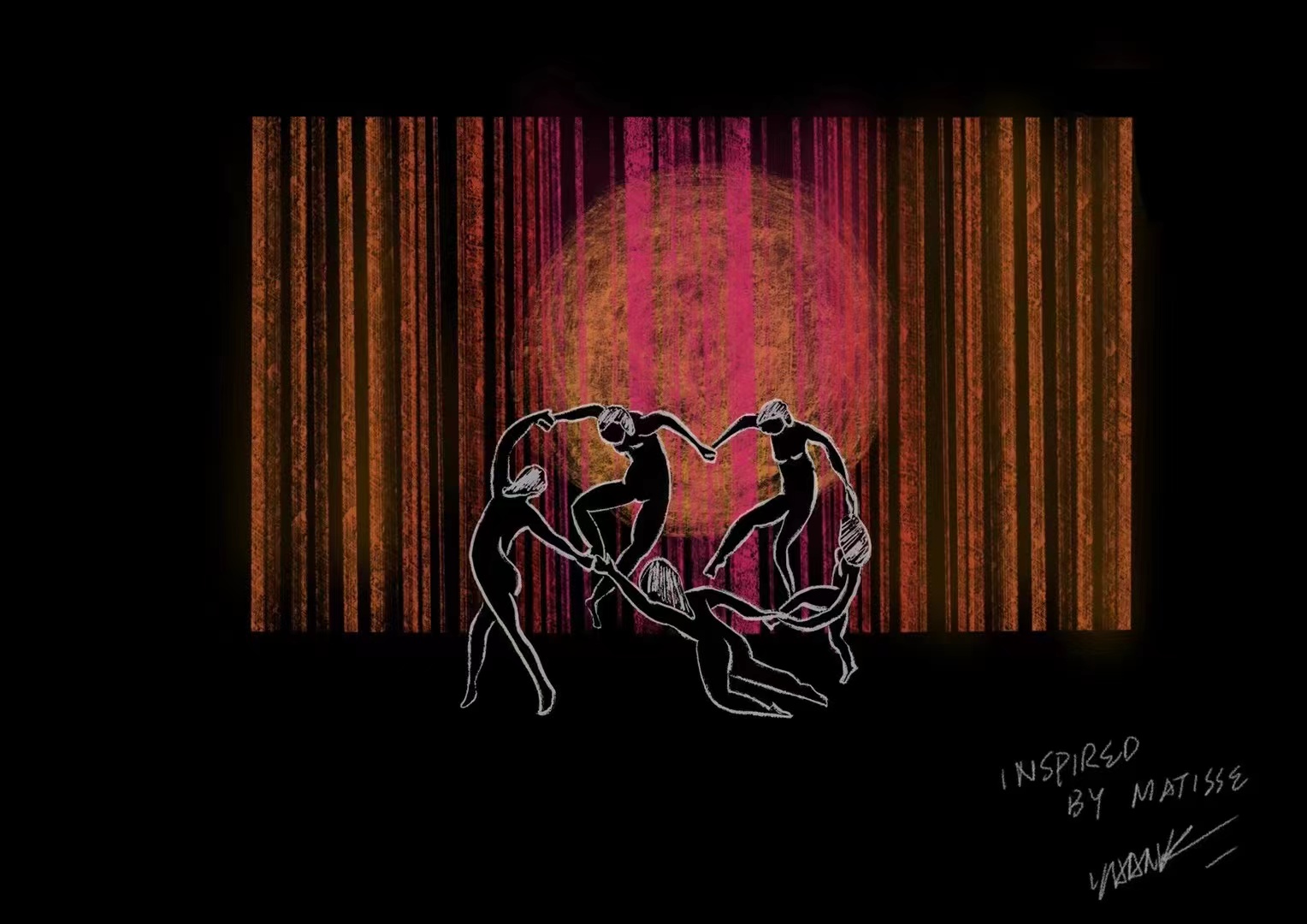
24 Solar Terms
廿四节气


The twenty-four solar terms are the knowledge system and social practice formed by the Chinese people by observing the annual movement of the sun and understanding the changing laws of seasons, climate, phenology and other aspects of the year. It is the product of the ancient farming civilization and has guided traditional Chinese agricultural production and daily life for thousands of years.
As far back as the Spring and Autumn Period, the ancient Chinese sages set the four solar terms of mid-spring, mid-summer, mid-autumn and mid-winter, and continued to improve and perfect them in the future. By the Qin and Han dynasties, the twenty-four solar terms had been fully established and had become a supplementary calendar in ancient China to guide farming.
二十四节气是中国人通过观察太阳周年运动,认知一年中时令、气候、物候等方面变化规律形成的知识体系和社会实践,是上古农耕文明的产物,千年以来指导着中国传统农业生产和日常生活。
远在春秋时期,中国古代先贤就定出仲春、仲夏、仲秋和仲冬等四个节气,以后不断地改进和完善。到秦汉年间,二十四节气已完全确立,成为中国古代一种用来指导农事的补充历法。
As far back as the Spring and Autumn Period, the ancient Chinese sages set the four solar terms of mid-spring, mid-summer, mid-autumn and mid-winter, and continued to improve and perfect them in the future. By the Qin and Han dynasties, the twenty-four solar terms had been fully established and had become a supplementary calendar in ancient China to guide farming.
二十四节气是中国人通过观察太阳周年运动,认知一年中时令、气候、物候等方面变化规律形成的知识体系和社会实践,是上古农耕文明的产物,千年以来指导着中国传统农业生产和日常生活。
远在春秋时期,中国古代先贤就定出仲春、仲夏、仲秋和仲冬等四个节气,以后不断地改进和完善。到秦汉年间,二十四节气已完全确立,成为中国古代一种用来指导农事的补充历法。
In the international meteorological circle, the 24 solar terms are known as "China's fifth greatest invention".
在国际气象界,二十四节气被誉为“中国的第五大发明”。
"Twenty-four solar terms" are based on the position of the sun on the ecliptic (the orbit of the earth revolving around the sun), which is the metric coordinate (longitude) on the ecliptic. According to astronomical conventions, the vernal equinox is measured from west to east, divided into 360 degrees. The ancients divided the 360 degrees of the ecliptic longitude of the sun into 24 equal parts, each of 15 degrees, and each 15 degrees is a solar term. The number of days between the two solar terms is about 15 days, and there are 24 solar terms throughout the year.
“二十四节气”是依据太阳在回归黄道(地球绕太阳旋转的轨道)上的位置制定,黄经是黄道上的度量坐标(经度)。按天文学惯例,以春分点为起点自西向东度量,分360度,古人把太阳黄经的360度划分成24等份,每份15度,每15度为一个节气。两个节气间相隔日数为15天左右,全年即有二十四节气。
![]()
“二十四节气”是依据太阳在回归黄道(地球绕太阳旋转的轨道)上的位置制定,黄经是黄道上的度量坐标(经度)。按天文学惯例,以春分点为起点自西向东度量,分360度,古人把太阳黄经的360度划分成24等份,每份15度,每15度为一个节气。两个节气间相隔日数为15天左右,全年即有二十四节气。

The twenty-four solar terms scientifically reveal the laws of astronomical and meteorological changes. It combines astronomy, natural rhythms and folk customs ingeniously, and generates a large number of related seasonal culture, which has become an important part of the traditional culture of the Chinese nation. In order to more accurately express the characteristics of the time sequence, the ancients divided the solar terms into four groups according to climate and phenology. "Fen" means the spring equinox and autumn equinox, which was called "two points" in ancient times; "Zhi" means the summer solstice and winter solstice, which was called "two solstice" in ancient times; "Qi" means the beginning of spring and beginning of summer, and "Bi" means the beginning of autumn and beginning of winter. Beginning of Spring, Beginning of Summer, Beginning of Autumn and Beginning of Winter are collectively referred to as the "Si li", which add up to "eight festivals". It is called "Four Seasons and Eight Festivals" or "Eight Seasons of the Year" among the people. In the long farming society, the twenty-four solar terms have played an important role in guiding agricultural activities and have rich cultural connotations.
二十四节气科学地揭示了天文气象变化的规律,它将天文、自然节律和民俗实现了巧妙的结合,衍生了大量与之相关的岁时节令文化,成为中华民族传统文化的重要组成部分。为了更准确地表述时序特点,古人根据气候和物候,将节气分为“分、至、启、闭”四组。“分”即春分和秋分,古称“二分”;“至”即夏至和冬至,古称“二至”;“启”是立春和立夏,“闭”则是立秋和立冬。立春、立夏、立秋、立冬,合称“四立”,这些加起来共为“八节”。民间称为“四时八节”或“时年八节”。在漫长的农耕社会中,二十四节气为指导农事活动发挥了重要作用,拥有丰富的文化内涵。
二十四节气科学地揭示了天文气象变化的规律,它将天文、自然节律和民俗实现了巧妙的结合,衍生了大量与之相关的岁时节令文化,成为中华民族传统文化的重要组成部分。为了更准确地表述时序特点,古人根据气候和物候,将节气分为“分、至、启、闭”四组。“分”即春分和秋分,古称“二分”;“至”即夏至和冬至,古称“二至”;“启”是立春和立夏,“闭”则是立秋和立冬。立春、立夏、立秋、立冬,合称“四立”,这些加起来共为“八节”。民间称为“四时八节”或“时年八节”。在漫长的农耕社会中,二十四节气为指导农事活动发挥了重要作用,拥有丰富的文化内涵。
chūn yǔ jīng chūn qīng gǔ tiān , xià mǎn máng xià shǔ xiāng lián ,
qiū chǔ lù qiū hán shuāng jiàng , dōng xuě xuě dōng xiǎo dà hán ,
shàng bàn nián lái liù niàn yī , xià bàn nián shì bā niàn sān ,
měi yuè liǎng jié bù biàn gēng , zuì duō xiāng chà yī liǎng tiān ...
春雨惊春清谷天,夏满芒夏暑相连,秋处露秋寒霜降,冬雪雪冬小大寒,
上半年来六廿一,下半年是八廿三,每月两节不变更,最多相差一两天......
The twenty-four solar term songs connect our perception of the sequence of the four seasons and the prosperity of all things. Countless poems and design works are derived from the solar terms, making daily life more enjoyable...
”wēi yǔ zhòng huì xīn , yī léi jīng zhé shǐ . tián jiā jī rì xián, gēng zhǒng cóng cǐ qǐ . “This poem by Wei Yingwu, a poet in the Tang Dynasty, expresses the rhythm and rhythm of the Chinese people's "sense of time and things". The beginning of spring, bites the ‘spring’, the spring divides, erect the egg, the grain rain fights the tea, and the beginning of the winter eats the sugarcane...reflects the wisdom of the Chinese nation to respect nature and adapt to the weather.
二十四节气歌,串连起我们对四季序列、万物枯荣的感知。由节气引申出了无数诗词和设计作品,让日复一日的生活变得有滋有味……
“微雨众卉新,一雷惊蛰始。田家几日闲,耕种从此起。”唐代诗人韦应物的这首诗表现了中国人“感时应物”的节气律动感。立春咬春、春分立蛋、谷雨斗茶、立冬食蔗……反映了华夏民族尊重自然、顺天应时的智慧。
qiū chǔ lù qiū hán shuāng jiàng , dōng xuě xuě dōng xiǎo dà hán ,
shàng bàn nián lái liù niàn yī , xià bàn nián shì bā niàn sān ,
měi yuè liǎng jié bù biàn gēng , zuì duō xiāng chà yī liǎng tiān ...
春雨惊春清谷天,夏满芒夏暑相连,秋处露秋寒霜降,冬雪雪冬小大寒,
上半年来六廿一,下半年是八廿三,每月两节不变更,最多相差一两天......
The twenty-four solar term songs connect our perception of the sequence of the four seasons and the prosperity of all things. Countless poems and design works are derived from the solar terms, making daily life more enjoyable...
”wēi yǔ zhòng huì xīn , yī léi jīng zhé shǐ . tián jiā jī rì xián, gēng zhǒng cóng cǐ qǐ . “This poem by Wei Yingwu, a poet in the Tang Dynasty, expresses the rhythm and rhythm of the Chinese people's "sense of time and things". The beginning of spring, bites the ‘spring’, the spring divides, erect the egg, the grain rain fights the tea, and the beginning of the winter eats the sugarcane...reflects the wisdom of the Chinese nation to respect nature and adapt to the weather.
二十四节气歌,串连起我们对四季序列、万物枯荣的感知。由节气引申出了无数诗词和设计作品,让日复一日的生活变得有滋有味……
“微雨众卉新,一雷惊蛰始。田家几日闲,耕种从此起。”唐代诗人韦应物的这首诗表现了中国人“感时应物”的节气律动感。立春咬春、春分立蛋、谷雨斗茶、立冬食蔗……反映了华夏民族尊重自然、顺天应时的智慧。
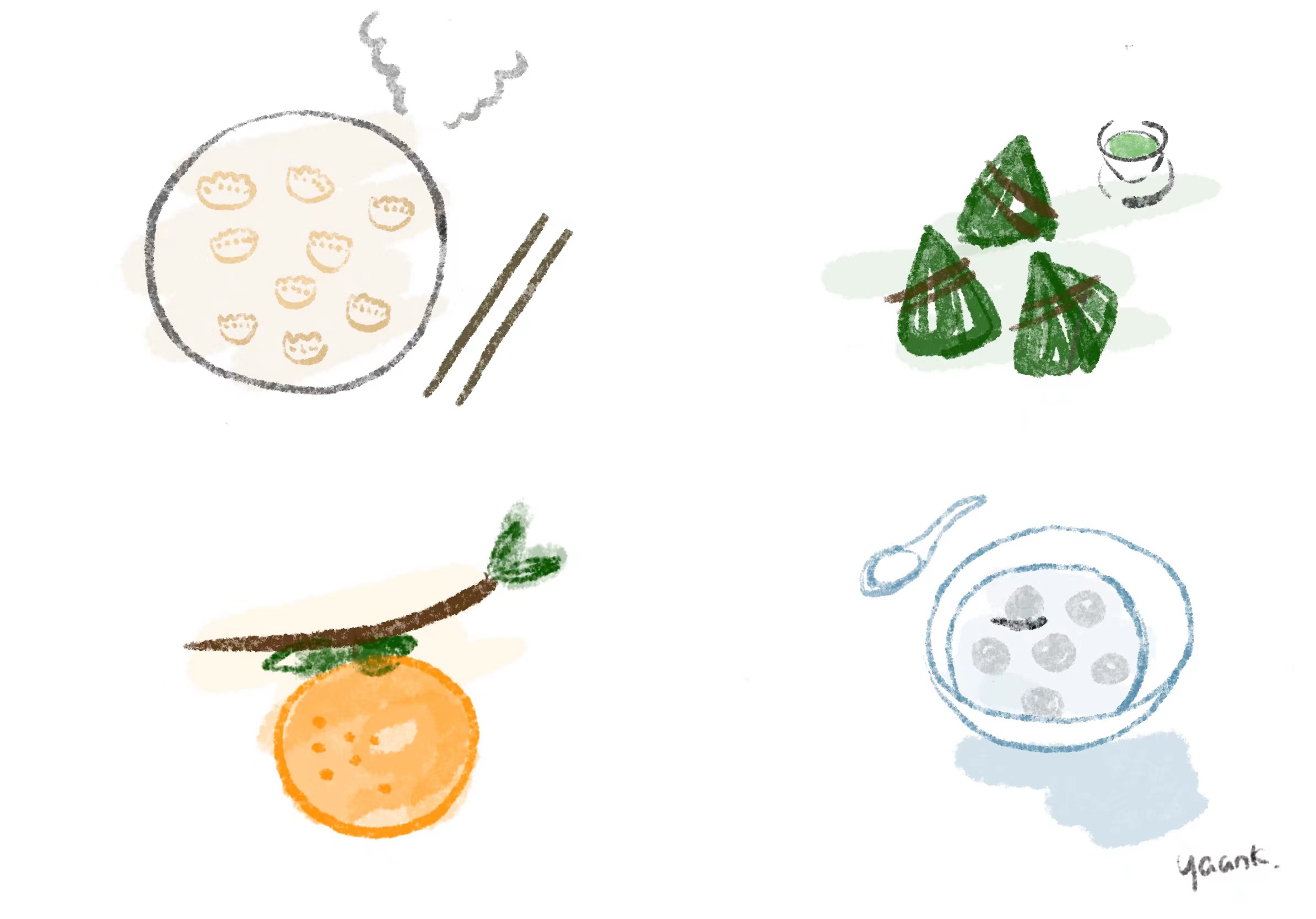
YAANK takes the twenty-four solar terms as the intention carrier, and uses color and light to interpret the understanding of the twenty-four solar terms.
YAANK以二十四节气为意向载体,用色彩和光来诠释对于二十四节气的理解。
Design & Production

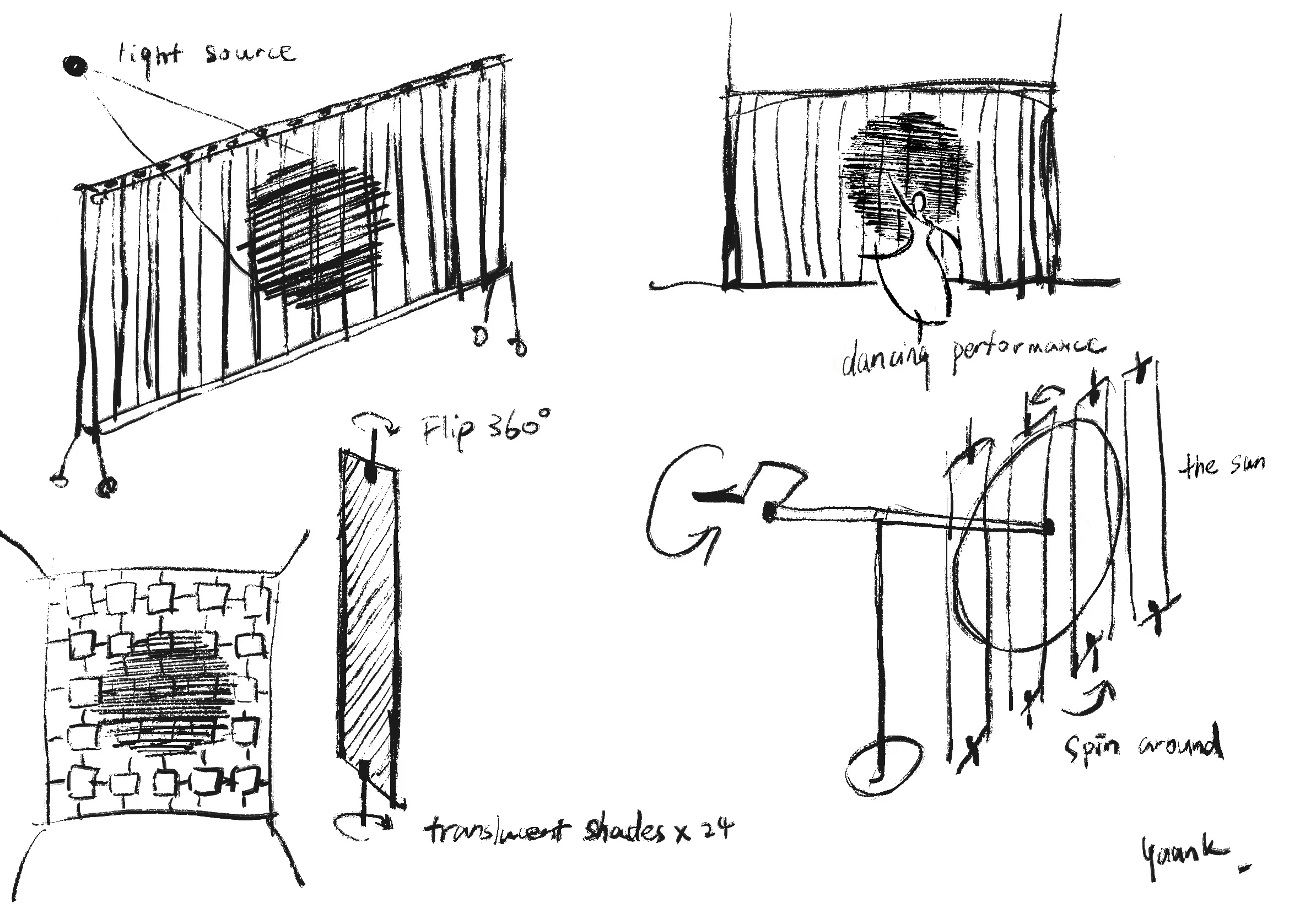
The from of “dimensionality” adopts the “Round sky and Square land”that the ancients have always believed in as its presentation method. “Round sky”refers to the “time of the sky that repeats itself like sixty years of age; and the “Square land” is derived from the “square” concept of “southeast, northwest,” which describes orientation.
“Round sky and Square land”embodies the concept of time and space of the ancient Chinese, and describes the natural laws of the universe. Therefore, the ancients believed that the "unity of heaven and man" can be adapted to the ever-changing laws of nature.
“维度”的造型选用古人一直信奉的“天圆地方”为呈现方式。“天圆”指的是“天时”如六十甲子一般周而复始;而“地方”的“方”则是源于描述方位的“东南西北”的“四方”观念。
“天圆地方”体现了中国古人的时空观念,描述了宇宙的自然规律,因此古人认为应当“天人合一”,才能顺应不断变化的自然规律,这与中华古今对于二十四节气顺天应时的理解相得益彰。
“Round sky and Square land”embodies the concept of time and space of the ancient Chinese, and describes the natural laws of the universe. Therefore, the ancients believed that the "unity of heaven and man" can be adapted to the ever-changing laws of nature.
“维度”的造型选用古人一直信奉的“天圆地方”为呈现方式。“天圆”指的是“天时”如六十甲子一般周而复始;而“地方”的“方”则是源于描述方位的“东南西北”的“四方”观念。
“天圆地方”体现了中国古人的时空观念,描述了宇宙的自然规律,因此古人认为应当“天人合一”,才能顺应不断变化的自然规律,这与中华古今对于二十四节气顺天应时的理解相得益彰。
By using simple mechanical motion to express the formation of “solar terms”, ”Dimensionality” uses electric energy to drive the mechanical shaft to rotate, so when that 24 grille blades simulate the revolution of the sun, the rules appear.
利用简单的机械运动表达“节气”的形成,“维度”采用电能带动机械轴转的方式,使24个格栅叶片模拟太阳的公转,叶片每转动15°为一个节气的转换,呈现出节气的变换规律;
![]()
利用简单的机械运动表达“节气”的形成,“维度”采用电能带动机械轴转的方式,使24个格栅叶片模拟太阳的公转,叶片每转动15°为一个节气的转换,呈现出节气的变换规律;
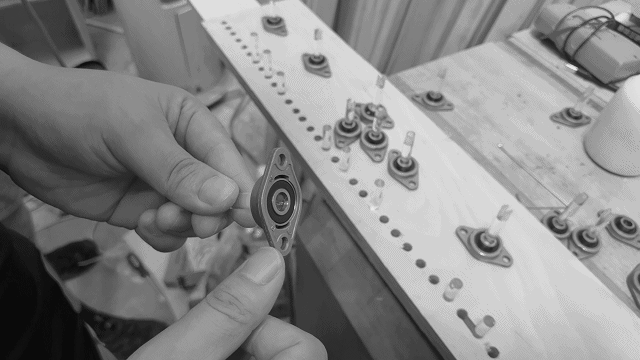

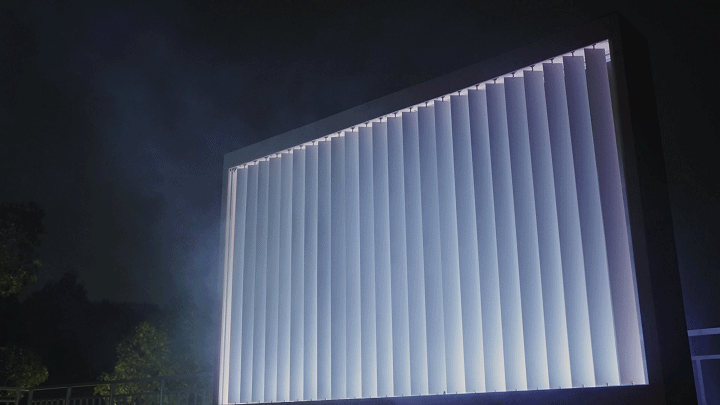
The blades are made of flexible materials, which can stay still when there is no wind in an orderly state; when there is wind, the blades can sway with the wind in a disordered state. It can consider as a natural visual performance.
nature.
叶片选用柔韧的材料,无风时可以保持静止,是一种有序的状态;当有风时叶片可以随风摇摆,一种无序的状态,一种自然的可视化表现。
nature.
叶片选用柔韧的材料,无风时可以保持静止,是一种有序的状态;当有风时叶片可以随风摇摆,一种无序的状态,一种自然的可视化表现。


Two concentric circles, one stationary and the other rotating at a constant speed around the center of the circle, simulate the rotation of the sun, and at the same time use the rotating motion and the texture of the material itself to fragment the light, presenting a more psychedelic lighting effect. By using light combines design, technology and materials to create an immersive lighting experience that senses the shifts of solar terms in color and light.
两个同心圆,一个静止,另一个围绕圆心匀速旋转,模拟太阳自转,同时利用旋转运动和材质自身的纹理,对光进行碎片化的处理,呈现更为迷幻的灯光效果。用光将设计、技术和材料结合起来,创造出沉浸式的灯光体验,在色彩与光中感应节气的变换。

Traditional Chinese Colours
"Dimensionanlity" is based on traditional Chinese colors, extracts classical poems and collides with traditional calendars. The unique romance of Chinese people pours out.
“维度”以中国传统色为基础,提取古典诗词碰撞传统历法,中国人独有的浪漫倾泻而出。
“维度”以中国传统色为基础,提取古典诗词碰撞传统历法,中国人独有的浪漫倾泻而出。


Li Chun: ”Snow on the plum was blown by the east wind, Spring for the world was arrived after the vernal breeze.”
As the first one of the Twenty-four Solar terms, Li means "beginning"; Chun represents warmth and growth, marking the end of the lifeless winter and the beginning of the vitality spring.
It is represented by the traditional Chinese color, "Cang huang", "If the silk is dyed cyan, the colour will be cyan or it can be yellow if dyed yellow " —"Mo Zi·Suoran", which is both a gradient and a change in color.It is often used as a metaphor for the change of things.
立春:“东风吹散梅梢雪,一夜挽回天下春。”
二十四节气之首,立,是“开始”之意;春,代表着温暖、生长,标志着万物闭藏的冬季已过去,开始进入风和日暖、万物生长的春季。
用中国传统色—“苍黄”表示,“染于苍则苍,染于黄则黄。—《墨子·所染》”,既是间色,也是变色,比喻事物的变化。

Da Shu: ”Full moon opens the midnight time, fireflies light up the night sky.”
As the last one of the Twenty-four Solar terms, Shu means “hot”; Da Shu refers to the extreme heat moment which is the most intense and hottest solar term of the year.
The color for the rise of Da Shu is "Xilan", "The evening mist of the mountains makes the scenery looming with afterglow of the sunset" —"Wang Wei· MuLanChai", is the color of the residual sun dyed slightly reddish in the mountain mist at dusk; The color for the change of the Da Shu is "Jiangsha", which is like the Orange-red light silk mixed with the remaining hot of the day.
大暑:“桂轮开子夜,萤火照空时。”
夏季最后一个节气。“暑”是炎热的意思,大暑,指炎热之极,是一年中阳光最猛烈、最炎热的节气。
大暑之起色“夕岚”,“彩翠时分明,夕岚无处所。—《王维·木兰柴》”,是日暮时分残阳染得山间雾气都微微泛红的色彩;而大暑之转色“绛纱”,则如绛色的轻纱层层叠叠,和着一天残存的暑热。
As the last one of the Twenty-four Solar terms, Shu means “hot”; Da Shu refers to the extreme heat moment which is the most intense and hottest solar term of the year.
The color for the rise of Da Shu is "Xilan", "The evening mist of the mountains makes the scenery looming with afterglow of the sunset" —"Wang Wei· MuLanChai", is the color of the residual sun dyed slightly reddish in the mountain mist at dusk; The color for the change of the Da Shu is "Jiangsha", which is like the Orange-red light silk mixed with the remaining hot of the day.
大暑:“桂轮开子夜,萤火照空时。”
夏季最后一个节气。“暑”是炎热的意思,大暑,指炎热之极,是一年中阳光最猛烈、最炎热的节气。
大暑之起色“夕岚”,“彩翠时分明,夕岚无处所。—《王维·木兰柴》”,是日暮时分残阳染得山间雾气都微微泛红的色彩;而大暑之转色“绛纱”,则如绛色的轻纱层层叠叠,和着一天残存的暑热。

Han Lu:”Late autumn was found in startling, chrysanthemum turned yellow in the morning.”
As the late autumn festival of the Twenty-four Solar terms, it refers to the beginning of October in each year. The traditional customs of Han Lu mainly include touring among maples, eating sesame and crabs, drinking seasonal tea, etc. The color of maple was mentioned in “Xizhouqu” with description of a girl: “her thin clothes were as red as apricots, and her hair was as black as a little crow.”The color is like apricots mixed with yellow and red, which is like orange.
寒露:“寒露惊秋晚,朝看菊渐黄”
寒露是深秋的节令,干支历戌月的起始。寒露传统习俗主要有赏枫叶、吃芝麻、吃螃蟹、饮秋茶等。
“单衫杏子红,双鬓鸦雏色。—《西洲曲》”,杏子黄红,其色如橘。
As the late autumn festival of the Twenty-four Solar terms, it refers to the beginning of October in each year. The traditional customs of Han Lu mainly include touring among maples, eating sesame and crabs, drinking seasonal tea, etc. The color of maple was mentioned in “Xizhouqu” with description of a girl: “her thin clothes were as red as apricots, and her hair was as black as a little crow.”The color is like apricots mixed with yellow and red, which is like orange.
寒露:“寒露惊秋晚,朝看菊渐黄”
寒露是深秋的节令,干支历戌月的起始。寒露传统习俗主要有赏枫叶、吃芝麻、吃螃蟹、饮秋茶等。
“单衫杏子红,双鬓鸦雏色。—《西洲曲》”,杏子黄红,其色如橘。

Xiao Xue:”Snowflakes fluttered into the window, green bamboo turned as a white jade.”
"Xue(snow)" is the result of water vapor cold, representing cold and precipitation, the temperature change at this time is not strong and the precipitation is not large, so "Xiao Xue" is used as a metaphor for the climate traits of this season.
It is usually represented by the traditional Chinese color “Xing Lang”. As “Xu Ji·ShouzengCao” described: When the clear air from the earth and heaven merges, the sky are as green as blue.””Xing Lang”also called “Xing Lan”which is the color image derived from the corresponds to the allusion to the stars.
小雪:“六出飞花入户时,坐看青竹变琼枝。”
“雪”是水汽遇冷的产物,代表寒冷与降水,这时节的气候寒未深且降水未大,故用“小雪”来比喻这时节的气候特征。
用中国传统色—“星郎”表示“乾坤清气有时合,合作星郎青似蓝。—《徐玑·寿曾漕》”星郎即星蓝,其色上应列宿,郎官对应星宿的典故,衍生而出的颜色意象。
"Xue(snow)" is the result of water vapor cold, representing cold and precipitation, the temperature change at this time is not strong and the precipitation is not large, so "Xiao Xue" is used as a metaphor for the climate traits of this season.
It is usually represented by the traditional Chinese color “Xing Lang”. As “Xu Ji·ShouzengCao” described: When the clear air from the earth and heaven merges, the sky are as green as blue.””Xing Lang”also called “Xing Lan”which is the color image derived from the corresponds to the allusion to the stars.
小雪:“六出飞花入户时,坐看青竹变琼枝。”
“雪”是水汽遇冷的产物,代表寒冷与降水,这时节的气候寒未深且降水未大,故用“小雪”来比喻这时节的气候特征。
用中国传统色—“星郎”表示“乾坤清气有时合,合作星郎青似蓝。—《徐玑·寿曾漕》”星郎即星蓝,其色上应列宿,郎官对应星宿的典故,衍生而出的颜色意象。
......
Man and Nature

"Dimensionality" is the energy embodiment of the sun's movement, and at the same time contains the vivid cultural energy of the Chinese nation. The ever-changing light interferes with our perception of the outside world unconsciously, and subtly affects our experience of different weather.
“维度”是太阳运动的能量体现,同时蕴含着中华民族鲜活的文化能量。不断变换的光在不知不觉中干预我们对外界的认知,在潜移默化中影响我们对大千气象的体验。


"As elegant as an orchid and green, as graceful as a dragon moving," the dancer’s steps take "dimension" as the background, expressing the beauty of rhythm between man and nature, and expressing the simple emotion of respecting nature and coexisting harmoniously with the weather and nature.
Taking light as the starting point, using the natural timing as the song, and the folk customs as the dance, the abstract things are presented in a more profound and simple way. Turning the replacement of solar terms into the imagination of color, dance and music requires mobilizing all the senses of the body to feel it and be immersed in the scene.
“翩如兰苕翠,婉如游龙举”,曼妙的舞步以“维度”为背景,表现人与自然的韵律之美,表达出尊重自然、顺应天时与自然和谐共处的质朴情感。
以光为切入点,用自然时序为曲,民俗风情当舞,把抽象的东西呈现得更加深入浅出。将节气的更替化为对色彩、舞蹈、音乐的想象,需要调动身体的所有感官来感受,身临其境。
Taking light as the starting point, using the natural timing as the song, and the folk customs as the dance, the abstract things are presented in a more profound and simple way. Turning the replacement of solar terms into the imagination of color, dance and music requires mobilizing all the senses of the body to feel it and be immersed in the scene.
“翩如兰苕翠,婉如游龙举”,曼妙的舞步以“维度”为背景,表现人与自然的韵律之美,表达出尊重自然、顺应天时与自然和谐共处的质朴情感。
以光为切入点,用自然时序为曲,民俗风情当舞,把抽象的东西呈现得更加深入浅出。将节气的更替化为对色彩、舞蹈、音乐的想象,需要调动身体的所有感官来感受,身临其境。

Artistic Objectives
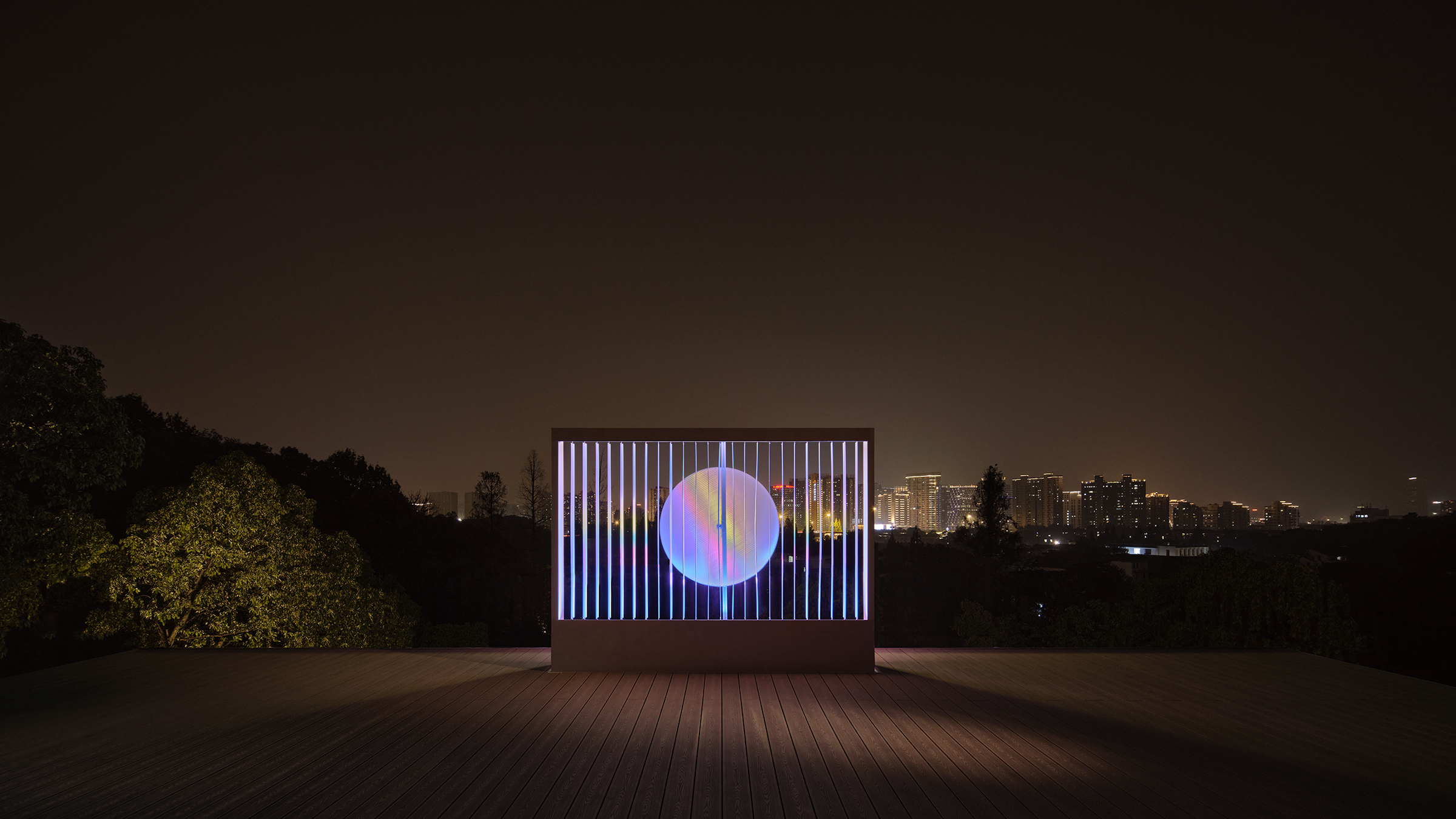
The twenty-four solar terms are "the marks that Chinese people add to life with nature", and a set of "sensing devices" in the collective consciousness of the Chinese nation; and "dimension" is to return life to the beauty of rhythm, adapt to a beautiful vision that conforms to the rule of nature.
二十四节气是“中国人用大自然给生活加上的标记”,是华夏民族集体意识里的一套“天人感应装置”;而“维度”是想让生活回归韵律之美,适应节律,顺应自然规律的美好愿景。
二十四节气是“中国人用大自然给生活加上的标记”,是华夏民族集体意识里的一套“天人感应装置”;而“维度”是想让生活回归韵律之美,适应节律,顺应自然规律的美好愿景。

Nowadays, our sense of life rhythm is interfered by man-made situation, it is difficult to adapt to nature rhythm. Taking artificial lighting design as an example, more and more lighting projects are done. When night falls, advertising and neon lights on shopping malls and hotels dazzling just like the day. In such a "city that never sleeps", the excessively strong light source caused by light intrusion affects the daily rest of others and making it difficult to fall asleep at night. It also disturbing the normal biological clock of the human body and resulting in low work efficiency during the day.
如今我们的生活节律感被人工所干扰,难以顺应自然。以人工照明设计为例,越来越多的亮化工程启动,当夜幕降临后,商场、酒店上的广告灯、霓虹灯闪烁夺目,令人眼花缭乱。有些强光束甚至直冲云霄,使得夜晚如同白天一样,即所谓人工白昼。在这样的“不夜城”里,光入侵造成过强的光源影响了他人的日常休息,使夜晚难以入睡,扰乱人体正常的生物钟,导致白天工作效率低下。
如今我们的生活节律感被人工所干扰,难以顺应自然。以人工照明设计为例,越来越多的亮化工程启动,当夜幕降临后,商场、酒店上的广告灯、霓虹灯闪烁夺目,令人眼花缭乱。有些强光束甚至直冲云霄,使得夜晚如同白天一样,即所谓人工白昼。在这样的“不夜城”里,光入侵造成过强的光源影响了他人的日常休息,使夜晚难以入睡,扰乱人体正常的生物钟,导致白天工作效率低下。

The sky was too bright to see the stars, which affected astronomical observation, aviation, etc., and many observatories were forced to stop working. According to astronomical statistics, when the sky is not polluted by light at night, about 7,000 stars can be seen, while in large cities where street lights, background lights, and landscape lights are scattered randomly, only about 20 to 60 stars can be seen. The sun, moon and stars have become the beauty that we lost.
天空太亮,看不见星星,影响了天文观测、航空等,很多天文台因此被迫停止工作。据天文学统计,在夜晚天空不受光污染的情况下,可以看到的星星约为7000颗,而在路灯、背景灯、景观灯乱射的大城市里,只能看到大约20~60颗星星,日月星辰成了我们丢失的美好。
天空太亮,看不见星星,影响了天文观测、航空等,很多天文台因此被迫停止工作。据天文学统计,在夜晚天空不受光污染的情况下,可以看到的星星约为7000颗,而在路灯、背景灯、景观灯乱射的大城市里,只能看到大约20~60颗星星,日月星辰成了我们丢失的美好。
"Dimension" is the result of YAANK's exploration of light, culture and nature in lighting design. There needs to be a contrast between light and dark. Only when there is darkness can there be light; when there is darkness, we can see the light. Rather than a game between brightness and darkness, this is a radical approach, and the final result is multiple losses of energy and human nature。
“维度”即是YAANK对照明设计中光、文化、自然探索的结果。需要让光明与黑暗相互映衬。有了黑暗,才能显出光明;有了黑影,我们才看得见光。而不是在亮度与亮度之间博弈,这是一种激进的处理方式,最终导致的结果就是能源和人本的多重损耗。


Reject the pollution of light to the environment, but let light and darkness contrast with each other.
Because of the blank space of "darkness", the sun, moon, and stars look stunning.
拒绝光对环境的污染,而是让光与暗相互映衬,因为有了“黑暗”的留白,日月星辰才显得绝色。

青空
SKY
SKY

Dimensionality

?
...
...
The story of YAANK LAB continues !
YAANK LAB的故事还在继续

